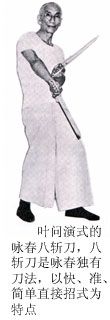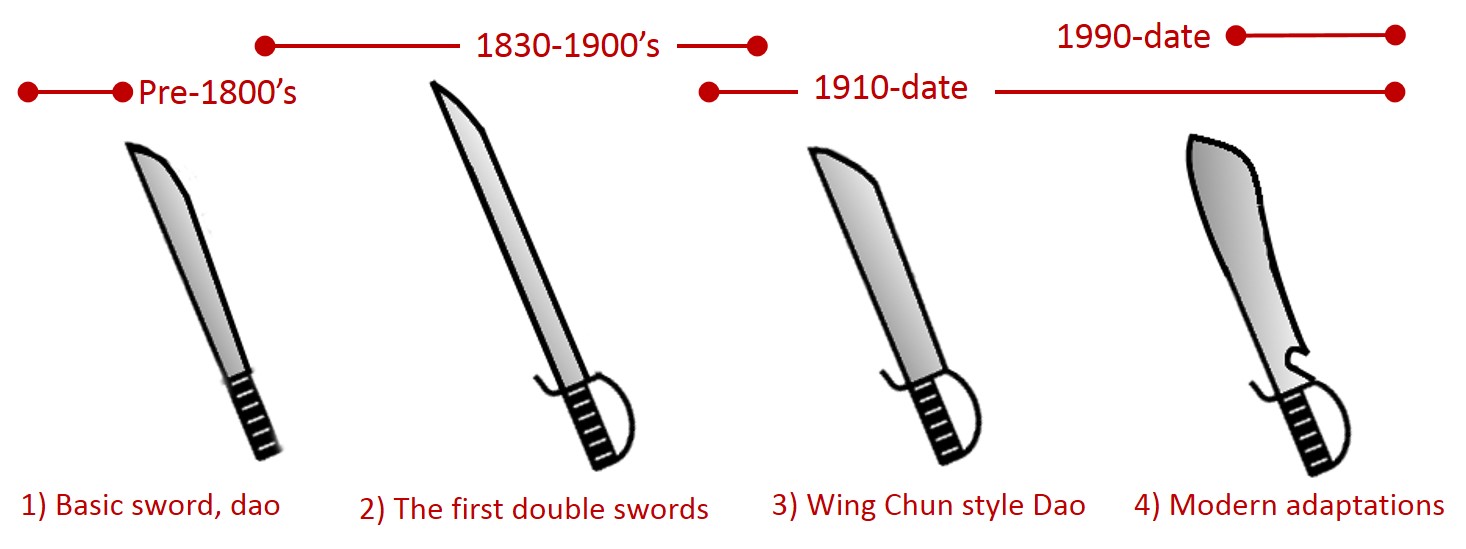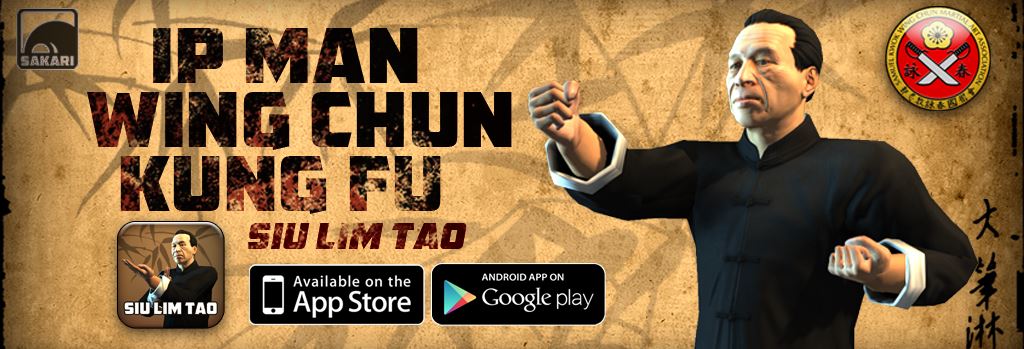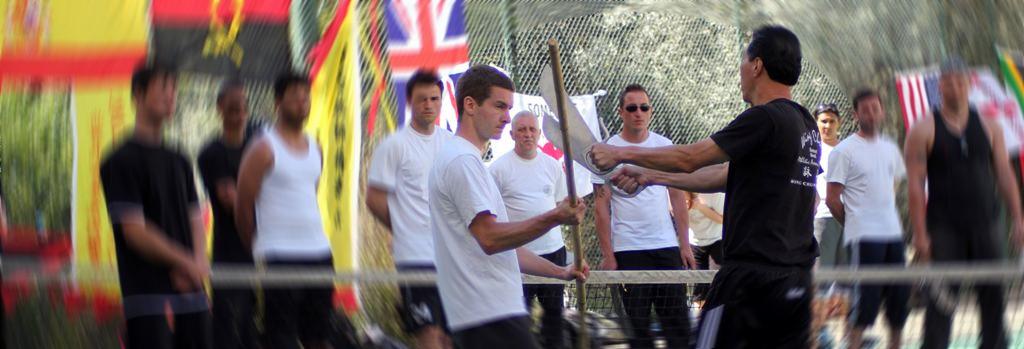Wing Chun Knife Form - Bart Cham Dao
Article by Dan Knight added on 24 Jul 2012. Last updated on 6 Jun 2015.
Eight cutting blades or Bart Cham Dao
The Wing Chun Butterfly Knife Form
 The Bart Cham Dao sometimes called Batt Jam Dao literally means eight cutting knives. Baat is the number 8, Cham is to cut or slash and Dao refers to a single edged blade like a knife or sword. This is usually the final form taught to a Wing Chun Student. Ip Man only taught a hand full (seven) of students this form in his entire life. Ip Man is said to have learned the form off of Leung Bik.
The Bart Cham Dao sometimes called Batt Jam Dao literally means eight cutting knives. Baat is the number 8, Cham is to cut or slash and Dao refers to a single edged blade like a knife or sword. This is usually the final form taught to a Wing Chun Student. Ip Man only taught a hand full (seven) of students this form in his entire life. Ip Man is said to have learned the form off of Leung Bik.
History of the form
Shaolin monk theory
There are a number of theories about the origin of the form. The most common theory, but in my opinion least likely theory, is that the form originated with the Shaolin monks. The fable goes, that the monks would keep the knives in their boots and use them to defend themselves. They were allegedly used so monks could incapacitate not kill their attackers and therefore still uphold their moral integrity. Whilst this is plausible, there are two key problems. One, there is no evidence that any of the Shaolin sets use Wing Chun style Dao in the same way as Wing Chun students do during the Baat Cham Dao form, namely rotating the blade so the spine of the blade runs parallel to the forearm. In fact some people[1] have suggested that, compressive research covering all the weapons used by the Shaolin styles, does not show any use of the Wing Chun style Dao. Secondly, a pair of large knives would not be a good choice for non lethal combat. A walking stick or plain metal baton would be cheaper and likely safer, non-lethal, self defense option.
Developed from Crane and other Kung Fu styles
An alternative theory is that the form was developed as an adaptation of other styles of Kung Fu that existed in southern China at the time, possibly Fujan White Crane. Fujan White Crane does use two Dao and rotates the blades during the form. However their form does not resemble the more modern Baat Cham Dao Form as done by Ip Man and Ip Ching. Therefore, to me, it seems likely that the Wing Chun form was inspired by other Chinese martial arts that existed at the time, but it had the Wing Chun principles of economy of motion, non-commitment and directness applied. This theory is supported by the fact a number of other southern Chines martial arts like Choi Lee Fut and Hung Gar etc, also use a pair of dao. Although again, they use them differently. In addition there is a fair amount of evidence[2] to suggest Wing Chun's hand forms are themselves and adaptation of Fujan crane style and snake style Kung Fu.
Everyday knives used for Wing Chun
Another possible theory is that the form is a way of using Wing Chun to fight with domestic knives, for instance Chinese cooking cleavers (which are sometimes used in pairs when cooking). Some people argue, the form can be seen as an extension of the hand techniques, just using a weapon. Whilst this is again a possibility, I feel this is an unlikely theory due to the nature of the form. In the final section of the Baat Cham Dao, the student is required to reverse the grip so the spine of the blade is parallel to the forearm. This is something that can only be done swiftly mid flow, by using the hooks on the back of the Dao, something which would not be present on a domestic knife of any sort. This last point leads nicely onto the evolution of the weapons themselves.
History of the weapon
Quite a bit of good research[3] has been done into the history of the weapon. As you have hopefully noticed, I have simply been referring to the weapon as Dao (meaning single edged blade in Cantonese), however it goes by a multitude of other names. I shall explore this terminology before looking at the history of the weapon itself.
Naming: Butterfly Knives, Hudiedao, Hu Die Dao or Wu Dip Dao?

Crossed Wing Chun swords in our association logo
Calling Wing Chun dao, Butterfly Knives is often very confusing for people outside of Wing Chun as the term is commonly used to describe the Filipino flick knife or balisong. The knives used in Wing Chun are nothing like the Filipino knives with the blade concealed in the handle. However the term butterfly knives is very common within the Wing Chun community. It was likely coined as a reference to the way people tend to mount the knives when putting them on display. i.e. crossed and resembling the shape of a butterfly with their wings open. People also refer to Wing Chun Dao as butterfly swords, which is more helpful, but still says very little about the sword.
The Chinese term for this is Wu Dip Dao. This is simply the Chinese term for Butterfly Knives/Swords. The word Dao or sometimes just spelled Do, can describe a tool which in English we have separate names for. For instance, we have the word knife, machete and sword. In Cantonese these can all be called Dao. However you would say Jian if the sword has an edge both sides but Dao if it only has one cutting edge. In English we can call these two separate thing by one name, sword. This linguistic issue is one reason for different names.
Some people call Wing Chun Dao, broadswords. Historically they seem to have been referred to as double swords.
... a curious double sword, capable of being used as one, and having but one sheath.
As described above in 1839, some of the first accounts of them[4] are documented in the west simply as double swords. For the purpose of this article I will call them Dao or Wing Chun Dao
Evolution of the Weapon

The above picture is a rough visualization of how the weapon evolved over time.

Like no 2) A set of mid. 19th century swords. Images credit.

Like no 3) A pair of Ip Man style swords. Swords for sale on site for £130.
In order to look at when this type of weapon seems to have arrived in history, we must first define what makes this weapon unique and therefore should be counted as separate to its predecessor. In this instance there are two very unique features to Wing Chun style Dao. Firstly, the hook on the back of the blade that allows the student to reverse the grip quickly. Secondly, the D shaped hand guard on the front is reasonably unique in that most Chinese weapons don't have that kind of guard. Given that we consider these two features to be what separates Wing Chun style Dao from regular knives and swords, we should next look at early references to these weapons and how they latter evolved.
It looks like the first appearance of these weapons was in the early to mind 19th Century (1800's). However the weapons from that time as seen in drawings, photos and historical collections show a blade that is far too long, far too thin and therefore too optimized for stabbing to be the kind of weapon used in Wing Chun's Baat Cham Dao. The stabbing aspect in the form is only found at the start of the second section, This means it makes up about 6-10% of the form. However there are numerous slashes in the form that cut through 8 angles (hence the name of the form). Therefore as the from encourages slashing, it seems reasonable that the early Dao were not created for Wing Chun rather, Wing Chun adapted the weapons that already existed. This idea supports the theory that the form is likely the evolution of an existing style in southern China at the time.
Evidence, suggests the the shorter blades, that are more optimized for slashing evolved at the very end of the 19th Century or start of the 20th Century. This suggested that the Baat Cham Dao forms appearance in Wing Chun is reasonably recent, perhaps only 50-120 years ago.
The forms structure
The form has 8 sections. Many people mistakenly believe this is where the forms name comes from. However the eight actually refers to the number of different angles the blade cuts through whilst performing the techniques in the form. Hence the name "eight cutting blade".
Obviously the form teaches the Wing Chun student how to use a pair of Wing Chun Dao (knives/swords). Butterfly knives are often confused with Bulls Ears swords. They look very similar however the difference in the handle of the weapon will dramatically reduce the functionality of a Bulls Ear sword compared to a pair Butterfly Knives.
Initially a student may ask "Although it may be fun to learn, and nice from traditional perspective, why should I learn the Bart Cham Dao in this day and age? I am never going to use it in the practical sense." So what else does learning the Bart Cham Dao help with?
Perhaps most importantly it reinforces the underlying Wing Chun principles seen in the other hand forms, for instance economy of motion, deflection etc. It will also teach the practitioner a new type of stepping that can be used in certain situations. Furthermore as an added bonus learning the Bart Cham Dao will drastically improve wrist strength if trained properly and regularly.
Furthermore because the knives used in the form are not as big as traditional Chinese swords the techniques translate well into improvised weapons you may find in a modern lifestyle.
Before the Bart Cham Dao can be learned it is very important to have a solid grasp of all the other hand forms first. This is because, amongst other things, the stepping in the Bart Cham Dao is not effective without the stepping from the second and third hand forms (Chum Kiu and Biu Gee). The system is designed to grow from the Sil Lim Tao to Bart Cham Dao and it is not wise to try and miss sections or rush through.

Wing Chun knives for sale in the UK
We now stock a small selection of high quality Wing Chun butterfly knives
The Wing Chun knife form video clip
The below video shows Samuel Kwok performing some of the Bart Cham Dao form at the World Wing Chun Conference.
Samuel Kwok performing some of the Bart Cham Dao form at the World Conference.
References & further reading on Wing Chun Knives
1. Wing Chun Weapons according to the Master Yuyen Chai Van (Nguyen Te Kong
1. Wing Chun Weapons according to the Master Yuyen Chai Van (Nguyen Te Kong
2. The true Origins of Wing Chun Part 1 by Sergio Iadarola
Tags for this article:
Knife FomBaat Cham DaoWeaponsLeung BikIp Man



